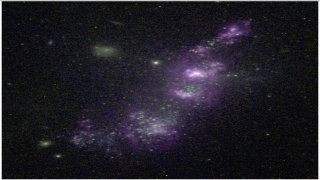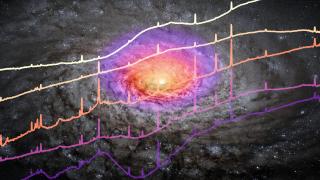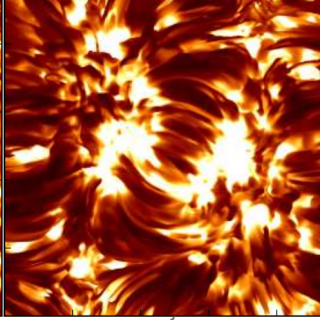Bibcode
Martínez-Paredes, M.; Alonso-Herrero, A.; Aretxaga, I.; Ramos Almeida, C.; Hernán-Caballero, A.; González-Martín, O.; Pereira-Santaella, M.; Packham, C.; Asensio Ramos, A.; Díaz-Santos, T.; Elitzur, M.; Esquej, P.; García-Bernete, I.; Imanishi, M.; Levenson, N. A.; Rodríguez Espinosa, J. M.
Bibliographical reference
Monthly Notices of the Royal Astronomical Society, Volume 454, Issue 4, p.3577-3589
Advertised on:
12
2015
Citations
19
Refereed citations
19
Description
We present an analysis of the nuclear infrared (IR, 1.6-18 μm)
emission of the ultraluminous IR galaxy UGC 5101 to derive the
properties of its active galactic nucleus (AGN) and its obscuring
material. We use new mid-IR high angular resolution (0.3-0.5 arcsec)
imaging using the Si-2 filter (λC = 8.7 μm) and
7.5-13 μm spectroscopy taken with CanariCam (CC) on the 10.4 m Gran
Telescopio CANARIAS. We also use archival Hubble Space Telescope/NICMOS
and Subaru/COMICS imaging and Spitzer/IRS spectroscopy. We estimate the
near- and mid-IR unresolved nuclear emission by modelling the imaging
data with GALFIT. We decompose the Spitzer/IRS and CC spectra using a
power-law component, which represents the emission due to dust heated by
the AGN, and a starburst component, both affected by foreground
extinction. We model the resulting unresolved near- and mid-IR, and the
starburst subtracted CC spectrum with the CLUMPY torus models of Nenkova
et al. The derived geometrical properties of the torus, including the
large covering factor and the high foreground extinction needed to
reproduce the deep 9.7 μm silicate feature, are consistent with the
lack of strong AGN signatures in the optical. We derive an AGN
bolometric luminosity Lbol ˜ 1.9 ×
1045 erg s-1 that is in good agreement with other
estimates in the literature.
Related projects

Starbursts in Galaxies GEFE
Starsbursts play a key role in the cosmic evolution of galaxies, and thus in the star formation (SF) history of the universe, the production of metals, and the feedback coupling galaxies with the cosmic web. Extreme SF conditions prevail early on during the formation of the first stars and galaxies, therefore, the starburst phenomenon constitutes a
Casiana
Muñoz Tuñón

Nuclear Activity in Galaxies: a 3D Perspective from the Nucleus to the Outskirts
This project consists of two main research lines. First, the study of quasar-driven outflows in luminous and nearby obscured active galactic nuclei (AGN) and the impact that they have on their massive host galaxies (AGN feedback). To do so, we have been granted time with the Gran Telescopio CANARIAS (GTC) in the optical and near-infrared ranges
Cristina
Ramos Almeida

Magnetism, Polarization and Radiative Transfer in Astrophysics
Magnetic fields pervade all astrophysical plasmas and govern most of the variability in the Universe at intermediate time scales. They are present in stars across the whole Hertzsprung-Russell diagram, in galaxies, and even perhaps in the intergalactic medium. Polarized light provides the most reliable source of information at our disposal for the
Ernest
Alsina Ballester